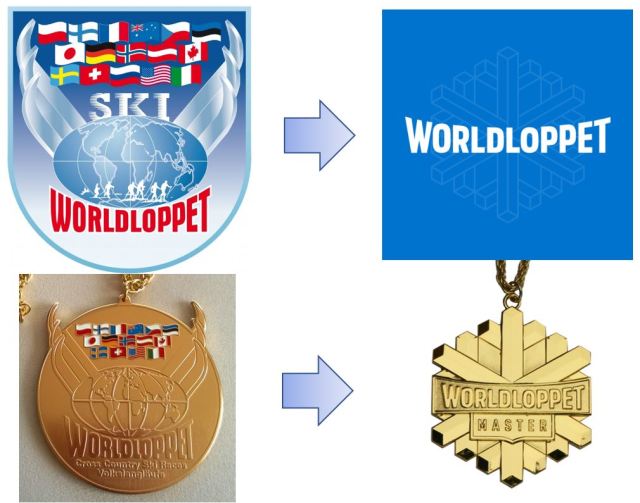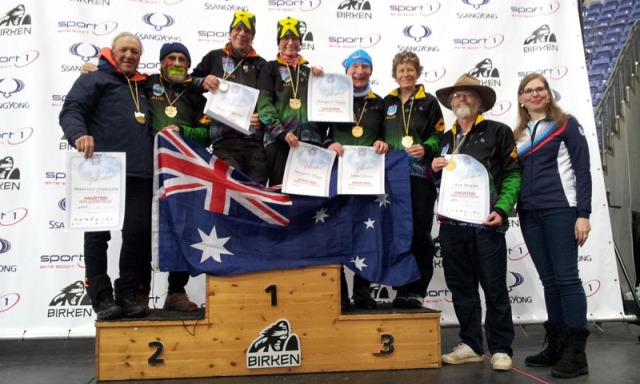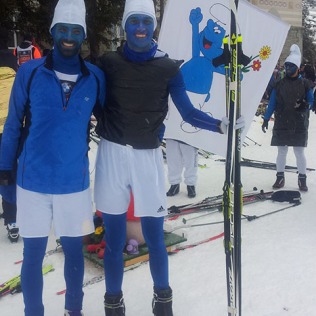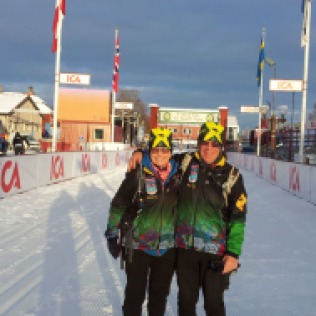Sweden’s Vasaloppet Week is amazing, as some 100,00 skiers participate in a variety of races leading up to the main race the actual 90km Vasaloppet on Sunday 4th March. Races include the 30km Kortvasan, the 30km Tjejvasan (Women’s race with some 14,000 participants), Halvvasan (45km), NightVasan(90km), a relay race and the Oppet Spär(90Km).
Getting entry into the actual 90km Vasaloppet is extremely difficult for us, as internet connections in our small town in country Australia are unreliable at the best of times, so trying to be online at the exact moment race entries were opened and trying to complete the race entry before the race was filled 5 minutes later was an impossible task for us. Instead, we entered the Oppet Spär which is the Vasaloppet Open Track, run on the same 90km course 1 week prior to the main race Being an Open Track there is no winner or trophies however individual skiers’ times are recorded and best of all qualifies a successful skier with a gold stamp for a Worldloppet passport. The start is low stress with a single line moving through a timing gate as opposed to a hectic mass start.
Arriving in Mora, Sweden (about 3.75 hours by train north of Stockholm) a few days before races commenced, we were extremely excited to see so much top quality snow. All the way north from Stockholm there was snow everywhere. Locals told us this was a superb snow season, the best in perhaps 20 to 50 yeas, and we were very happy to be part of it especially since on our last European Worldloppet ski trip in 2014 where we had had 3 race cancellations due to poor snow.
The atmosphere in Mora was building up with lots of road closures and barriers in place as all races finish in the main street of Mora, a medium sized regional town. The shops all displayed welcoming signs to skiers. We stayed at Mora Parken, a cabin park, less than 1km from the race finish. The actual race course went right through the park, so it was a great location to watch the multitude of races, as well as being able to ski right out the door when there wasn’t races happening. Ski waxing rooms are also provided at Mora Parken, facilities we struggled to find in many of our previous accommodations.
Friday 23rd February was the Kortvasan, a race along the final 30 kilometres of the Vasaloppet course. Successfully finishing the Kortvasan, some 12,000 skiers skied the gently undulating 30km course. It was extremely well-organised with skiers leaving in waves of approximately 1,000 skiers every 15 minutes from 9am from Oxberg. This meant the fastest skies in wave 1 were finished in Mora before the final waves commenced their race after 12 noon. It was -3 degrees and still in the forest. The recent snowfalls meant the snow was very light and fluffy resulting in slow glide. The tracks remained in good condition throughout, even for the slower, later skiers. The course was mostly in the forest with a few small villages being skied through. Enthusiastic spectators gathered at any possible road /race course junction to cheer skiers along, yelling “hejah, hejah.” It certainly spurred skiers on.
Sunday 25th February was Sondag Oppet Spär with some 7,200 skiers, there was also another Oppet Spar on Monday 26th February with 5,000 skiers. If staying in Mora, the 90km Oppet Spär involves catching a bus from Mora between 4am and 5am to be transported 2 hours to the event start at Salen. Being an Open Track, skiers could start anytime between 7am and 8am. Cut-off times seemed fairly generous, with the final being 7pm at Eldris, 9km from the finish.
Temperatures had dropped significantly in the 24hours before the Sunday Oppet Spar. It had been a pleasant -3 degrees with snow falling all day Saturday during the Tjejvasan, but predictions for Sunday was for -12 degrees rising to -8 degrees. However, when we arrived at Salen, the race start, at 6.30am, temperature gauges were displaying -17 degrees. Speedily, we got ready not wanting to linger in the cold. There was a plentiful supply of toilets, warm water was available and the baggage trucks displayed big number signs.
It didn’t seem too cold as we started skiing at about 7.15am, plus I figured with a 2 kilometre hill (the longest hill on the course) after only 1 km skiing, I would warm up quickly, however this wasn’t the case as the temperature seemed to get colder and colder, even expending energy climbing the hill didn’t warm me up. There was a moving queue on the big hill, much more so than when we had skied the Vasaloppet a few years ago. Up and up we went and finally reached the top of the hill crowded amongst the other skiers. The terrain then became undulating and continued like this all the way to Mora. There was a few larger ascents and descents in the middle of the course around Risberg/Evertsberg but realistically the track is fairly benign.
By the time I had skied 10 kilometres, I was bitterly cold; I knew I needed more clothing if I was to continue. Fortunately, I always carry a bumbag with light-weight jacket, warm gloves /and extra hat, otherwise I would have had to pull out as the risk of hypothermia was too high. I donned all my layers and it took another 5 kilometres before my frozen body started to warm up and I began to enjoy the pretty scenery with the first morning rays reflecting off the snow-covered trees. The race course passes numerous frozen lakes; some tiny, others expansive. Traditional wooden holiday cabins dotted the landscape. The sun gave little warmth, but it was glorious skiing under blue skies with superb lighting on the frozen landscape.
There are few ski races where the average citizen skier begins skiing before the sun rises and if fast enough finishes before the sun sets, though with the final cut off being 7pm at Eldris (9kms before the finish) tired skiers were skiing the last sections of the course in the dark, with some coming in as late as 8.30-9pm.
For the first part of the Oppet Spar the track is extremely wide with some 8 classic tracks extending for 20 + kilometres. Skiers were shoulder to shoulder, faster skiers zipping between tracks if a small gap occurred. Onto Evertsberg (halfway) there was 6 classic tracks and for the final part of the course there was 4 classic tracks. All the way it was busy making it important to pay attention to what other skiers were doing, especially on the downhills. The classic tracks held well considering the numbers.
The drink stations were masses of skiers, so busy and chaotic that at the first couple of stops it was a long queue to even get a drink. A few volunteers had trays of drinks but often you had to queue at tables. Choices were very limited with only water, blueberry drink, enervit, coffee (at some) and small bread rolls offered. I was extremely glad that in my pockets I had extra food bars, cashews and some sugary treats otherwise I would have been very hungry. I recommend skiers carry extra food with you for sustenance, unless white bread rolls are your food of choice.
Organisers managed the rubbish from skiers extremely well by providing many rubbish bins as well as marked zones where skiers could drop rubbish. There was also a 15 minute penalty for anyone dropping rubbish outside of these zones which is a brilliant idea as in some race like the Marcialonga we were appalled at the rubbish from energy sachets dropped in many locations along the race course. Maybe other races should enforce a similar time penalty for those who incorrectly dispose of their rubbish.
Every kilometre there was signage informing skiers how many kilometres to the finish and how many kilometres to the next drink station. Compared to most other Worldloppet races the signage was exceptional; being of a size that was easily seen, very clear and easy to understand. It was so good not having to do a mental calculation to work out how far to go.
Transport of warm clothes was efficiently conducted with trucks in start areas indicating race numbers where skier’s numbered plastic bags could be deposited. On finishing the race, skiers were transported via bus a couple of kilometres to the sports stadium where skiers collected their plastic bags then had warm showers before being bussed back to the start area to pick up skis and diplomas. Drinks and protein bars were available at the end of the race, but no meal was offered after any of the races except after the actual main Vasaloppet race.
Finishing the Oppet Spar I felt a real sense of achievement, having skied 90km in one freezing cold day and arriving before sunset in less than my friend’s prediction of 9 hours. I recommend the Oppet Spar to all Gold Worldloppet skiers, you should do it at least once in your Worldloppet career.
By Marg Hayes
Australia






 Staying in Lillehammer at the hostel above the train station is highly recommended as it very convenient when arriving by train. Also, the buses to the Nordic ski trails of Sjusjeon and Nordsetter depart from outside the station allowing skiers to prepare on the last third of the race course or just enjoy the 200kms of trails in the mountains above Lillehammer without having to climb up the 600+ vertical metres from Lillehammer.
Staying in Lillehammer at the hostel above the train station is highly recommended as it very convenient when arriving by train. Also, the buses to the Nordic ski trails of Sjusjeon and Nordsetter depart from outside the station allowing skiers to prepare on the last third of the race course or just enjoy the 200kms of trails in the mountains above Lillehammer without having to climb up the 600+ vertical metres from Lillehammer. Text by Hannes Larsson
Text by Hannes Larsson Assiduous WL skier
Assiduous WL skier





















